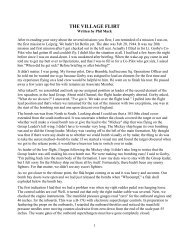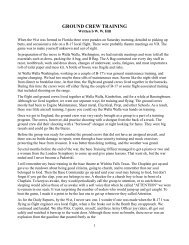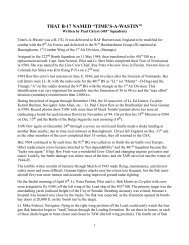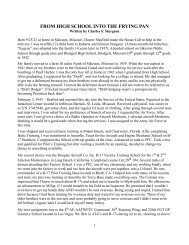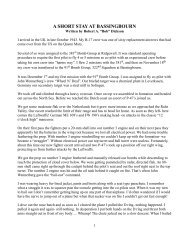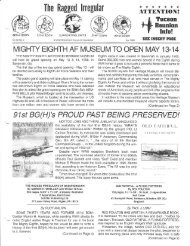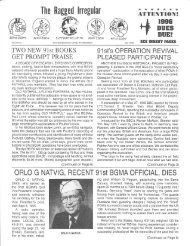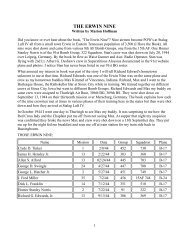Dailies of the 323rd - the 91st Bomb Group!
Dailies of the 323rd - the 91st Bomb Group!
Dailies of the 323rd - the 91st Bomb Group!
Create successful ePaper yourself
Turn your PDF publications into a flip-book with our unique Google optimized e-Paper software.
ombers have had <strong>the</strong> assistance <strong>of</strong> a strong fighter escort which<br />
has helped in keeping losses <strong>of</strong> ships and personnel to a minimum.<br />
29 March 1944: Brunswick, Germany was attacked on <strong>the</strong> 29th. While<br />
<strong>the</strong>re was a 10/10 formation <strong>of</strong> clouds over <strong>the</strong> target and bombing<br />
results could not be observed. All ships succeeded in dropping<br />
<strong>the</strong>ir bombs and returned safely to base. Not without considerable<br />
enemy opposition, however, for a change <strong>the</strong>y sent up quite a few<br />
number <strong>of</strong> fighters in an attempt to deal with our bombers and<br />
escorting aircraft. No ships or crew members were lost from this<br />
squadron, but <strong>the</strong>y reported <strong>the</strong> opposition a lot stronger than it<br />
had been for some days.<br />
The following ships and <strong>the</strong>ir crews represented this squadron:<br />
Ships #563, Lt. Gorby and crew; #151,Lt. Sheriff and crew; #909,<br />
Lt. Hackleman and crew, #075, Lt. Register and crew, #542, Capt.<br />
Ranzoni and crew, #513, Lt. Pryor and crew; #636, Lt. James and<br />
crew.<br />
30 March 1944: On <strong>the</strong> 30th, <strong>the</strong>re being no operational mission on<br />
our schedule combat crew members engaged in ground school and<br />
training activities. One crew went out to <strong>the</strong> skeet range; <strong>the</strong><br />
syn<strong>the</strong>tic trainers were all in operation; Radio operators<br />
attended classes,; and <strong>the</strong>re was a good attendance at Aircraft<br />
recognition classes. Four ships flew locally for a period <strong>of</strong><br />
about two hours each.<br />
31 march 1944: There was a mission scheduled for <strong>the</strong> 31st and<br />
everything made ready for <strong>the</strong> take<strong>of</strong>f, but, due to <strong>the</strong> inclement<br />
wea<strong>the</strong>r prevailing (one <strong>of</strong> <strong>the</strong> few snow squalls <strong>of</strong> <strong>the</strong> whole<br />
winter) this mission was scrubbed. Crews returned to <strong>the</strong>ir<br />
barracks after getting <strong>the</strong>ir equipment properly stored for<br />
ano<strong>the</strong>r day, and made ready to attend ground school.<br />
Pay Formation was held at 1400 hours.<br />
T/Sgt. Roy J. Schleich, Jr. Destroyed one FW-190 on March 2,<br />
1944. He was flying as waist gunner on Ship #774.<br />
S/Sgt. Merritt Hetager destroyed one FW-109 on 29 March 1944. He<br />
was flying as Ball Turret gunner on Ship #075.<br />
S/Sgt. Christopher A. Belmonte damaged one FW-190 on 29 March<br />
1944. He was flying as Tail Gunner on Ship #513.<br />
In <strong>the</strong> past <strong>the</strong> tour <strong>of</strong> operational duty for combat crew members<br />
has been twenty-five operational sorties over enemy territory.<br />
Recently, this policy has been changed so that an individual must<br />
complete at least thirty. He is <strong>the</strong>n given a period <strong>of</strong> rest and<br />
may <strong>the</strong>n be reassigned to do more missions. The idea is to<br />
utilize services <strong>of</strong> trained men more efficiently. At <strong>the</strong> time




